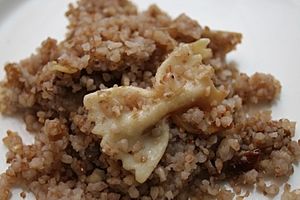Kasha varnishkes facts for kids
Kasha varnishkes is a traditional and tasty dish. It comes from the Ashkenazi Jewish community in America. This dish mixes kasha (which is buckwheat groats) with noodles. The noodles are usually bow-tie shaped egg noodles called lokshen.
Buckwheat groats are like small, crushed grains. They are cooked separately first. Then, they are fried together with the lokshen noodles. Sliced onions, called tsvibelach, are also added. Everything is fried in schmaltz, which is poultry fat, often from chickens. Sometimes, briye (chicken or beef stock) is used to cook the dish.
Where Kasha Varnishkes Comes From
Kasha varnishkes is a special part of Ashkenazi Jewish food. The Ashkenazi Jews lived in Eastern Europe for many years. They faced tough times and had to leave their homes. They moved to countries like the United States. When they moved, they brought their traditions and foods with them. Kasha varnishkes was one of these dishes. It became very popular in the American Jewish community.
The name varnishkes might come from a Ukrainian word. It sounds like varenyky, which are Ukrainian stuffed dumplings. Buckwheat was a common filling for these dumplings in Ukraine. Jewish people who moved from Ukraine made this dish even better in their own way.
A Look at Its History
One of the first times kasha varnishkes was mentioned was in a play. It was an 1898 Yiddish play called “Die Mumeh Sosye” (Aunt Sosya). A recipe for the dish appeared in a Yiddish American cookbook in 1925. That recipe showed noodles or dumplings filled with kashe. This was a bit different from the simpler dish we know today.
A food writer named Gil Marks thinks the dish grew popular in New York City. This happened in the late 1800s. Jewish immigrants and Italian pasta makers shared their food ideas. Later, in the mid-1900s, it became easier to buy dried pasta. This probably helped the dish change to use the bow-tie pasta we often see today.
See also

- In Spanish: Kasha varnishkes para niños


